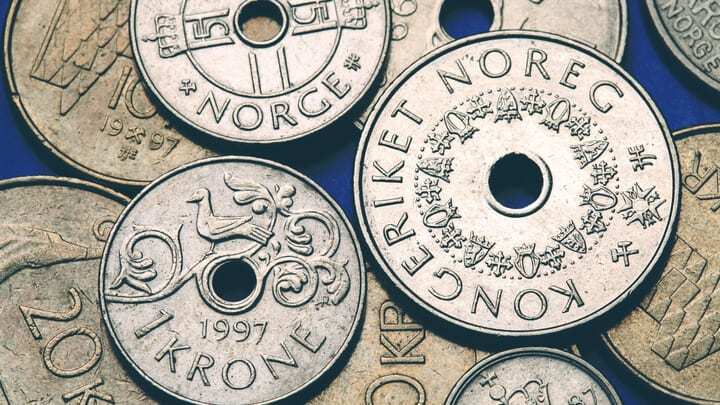Since its inception in 1816, Norges Bank has the exclusive right to issue banknotes in Norway.
In 1875, Norway received its monetary system in the form of Norwegian krone. The krona became the main coin and was divided into 100 øre. The crown could then be exchanged for gold. Banknotes were subject to also the bank's promise that they will be able to be redeemed at face value in gold. However, the guarantee was lifted after the gold standard was abolished in 1931.
Norges Bank currently issues banknotes in denominations of 1000, 500, 200, 100 and 50 NOK. The 10 kroner banknote was issued until 1984, and the 5 kroner banknote until 1964. Norwegian coins have denominations of 20, 10, 5, 1.
The number of coins minted was set by the king with the consent of the Storting
From 1825 to 1962, the number of coins minted was determined by the king with the consent of the Storting. The amount of coins is currently determined by Norges Bank, in accordance with the Act of 24 May 1985 on Norges Bank and the monetary system. The size, weight and nature of the coins are also determined by the bank.
. Production of coins and banknotes
In the Middle Ages and in the XNUMXth century, coins were minted in Oslo, Bergen and Nidaros. This was also done sporadically in the monasteries of Hamar, Tønsberg and Gimsøy. They were beaten by both the king and several archbishops.
Coin production takes place at the Norwegian Mint in Kongsberg, the former Royal Mint, which was founded in 1686. Previously, the Norwegian Mint was located in Christiania, which was founded in 1628 and closed in 1695.
The first banknotes were issued by Bergen, Jørgen Thor Møhlen, a merchant
The first Norwegian banknotes were issued by the Bergen merchant Jørgen Thor Møhlen in 1695. By royal decree of June 22 of the same year. However, this first attempt to issue Norwegian banknotes was unsuccessful for various reasons, leading to the bankruptcy of Thor Møhlen.
Scandinavian Monetary Union and links with other currencies
The krone as a means of payment was introduced in Norway in 1875 in connection with the country's accession to the Scandinavian Monetary Union (established in 1873). Apart from Norway, the Union included Sweden and Denmark. Within the union currency Norwegian krone had a gold standard of 2480 crowns to one kilogram of pure gold. It became the main coin and was divided into 100 øre. The main coins were minted in 20 crowns and 10 crowns. 10 crowns are the most sought after among collectors because they have the lowest mintage. From 1924, the silver coin was replaced by copper-nickel coins, which contained 75% copper and 25% nickel.
As part of the monetary union, the Norwegian krone had a gold standard of NOK 2480 per kilogram of pure gold. This standard was reintroduced between 1916 and 1920 and then between 1928 and 1931. In 1931 the krona was pegged to the British pound at the rate of 19,9 kronor per pound. In 1939, the crown was pegged to the US dollar at a rate of 4,4 crowns per dollar. During the occupation 1940–1945, the crown was tied to a German mark in the amount of 1 crown for 0,6 marks.
Iron coin
During both world wars, the lack of a monetary metal led to the printing of 1 and 2 kroner banknotes and the use of iron - during World War II also zinc - as a metal for coins. During World War II, the coins showed the national coat of arms without the royal crown, while the government in exile in London minted Norwegian coins with the royal crown. The latter in the history of Norwegian coins have been called "London coins" or "London series" and are highly sought after by collectors.
What about øre?
In 1972, the 1- and 2-øre minting, which since 1974 have ceased to be legal tender, were stopped. 5-øre and 25-øre were last minted in 1982 and ceased to be legal tender in 1984. 10-øre ceased to be legal tender on March 1, 1993.
A new series of coins in 1994
A new series of coins was launched in 1994, when the new 20 kroner coin was introduced to circulation. Then, in 1995, there were new 10 kroner, in 1996 50 øre, in 1997 one koruna and in 1998 five kronor. As of May 1, 2012, the 50 øre coin ceased to be compulsory tender in Norway
Now they are printed in printing houses abroad
Commemorative coins are minted on special occasions. Until 2007, banknotes were produced at the Norges Bank banknote printing plant in Oslo. Now they are printed in commercial printing houses abroad. Traditionally Norwegian kroner, Danish and Swedish are abbreviated as "kr.", to distinguish the Norwegian krone from the Danish and Swedish krone, the abbreviation "nkr" is also traditionally used. The term "NOK" dominates in international contexts.
Based on the Great Norwegian Lexicon



